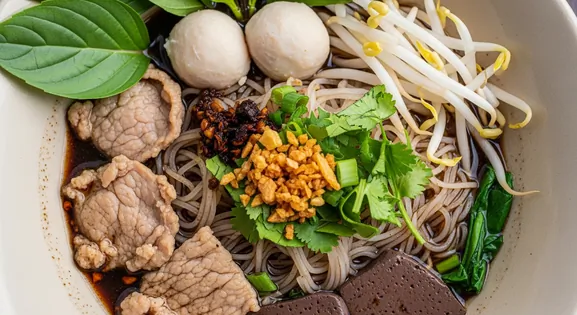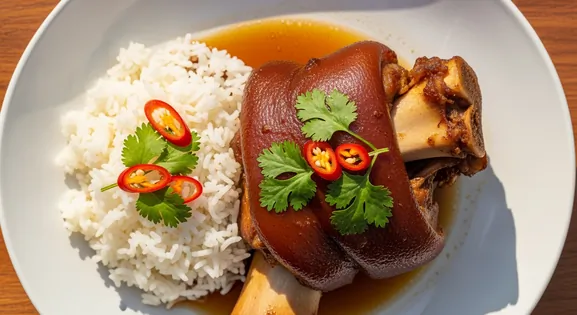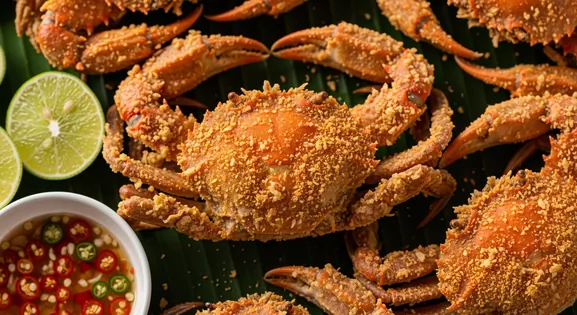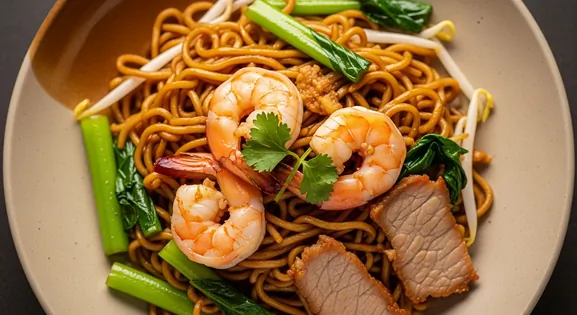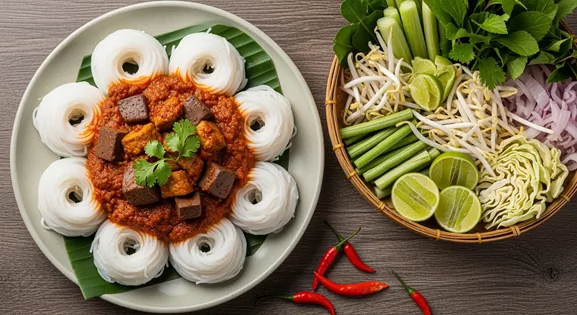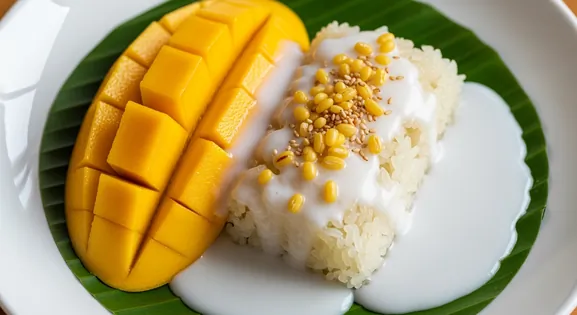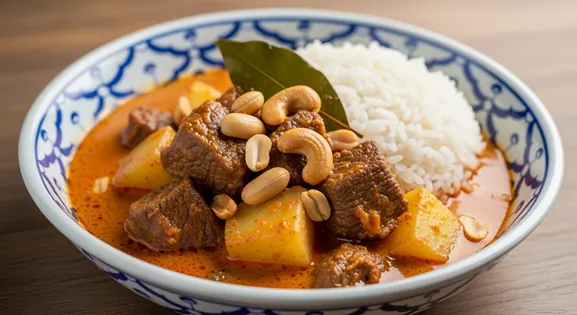Grilled Pork Skewers in Thailand: A Complete Food Lover's Guide
หมูปิ้ง (Moo Ping)
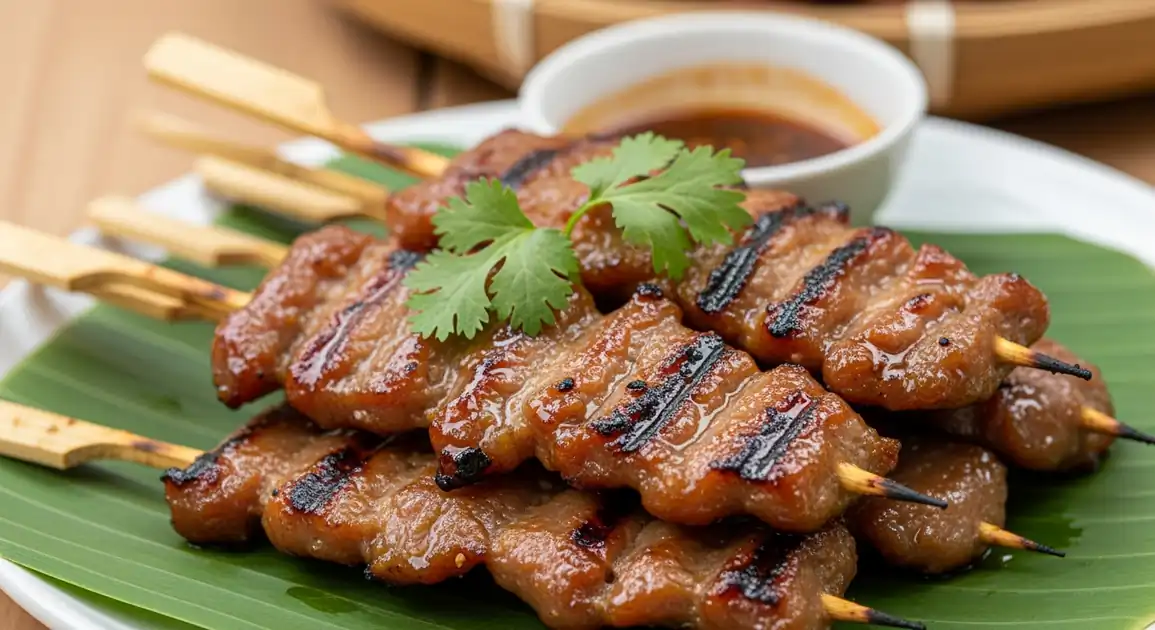
What is Grilled Pork Skewers (Moo Ping)?
Moo Ping (หมูปิ้ง) is Thailand's beloved grilled pork skewer street food, featuring succulent pieces of marinated pork shoulder or belly grilled over charcoal until caramelized. The distinctive sweet-savory marinade typically contains coconut milk, garlic, coriander root, palm sugar, and fish sauce, creating a complex flavor profile enhanced by smoky char. Generally served with sticky rice (khao niew) and spicy dipping sauce (nam jim jaew), it's a quintessential Thai breakfast or snack food available from street vendors throughout the country.
The Story Behind the Dish
Grilled meat on skewers is a cooking method found throughout Southeast Asia with variations in each country. Moo Ping evolved as a convenient, portable street food in Thailand, with regional adaptations based on local taste preferences. Originally a morning meal for workers, it has become a round-the-clock favorite for both locals and tourists. The dish represents Thailand's masterful balance of sweet, salty, and spicy flavors, along with the cultural significance of communal street dining that characterizes Thai food culture.
The Art of Preparation
Moo Ping starts with slicing pork (usually shoulder or belly with some fat content) into bite-sized pieces. The meat is marinated for at least 2-4 hours (often overnight) in a mixture typically containing minced garlic, coriander root, white pepper, palm sugar, fish sauce, soy sauce, and coconut milk. Some recipes include oyster sauce, honey, or condensed milk for additional sweetness. The marinated meat is threaded onto bamboo skewers and grilled over hot charcoal, continuously basted with marinade and turned frequently to develop caramelization while ensuring thorough cooking. The careful balance of high heat cooking while preventing burning is key to quality.
Key Ingredients of Grilled Pork Skewers (Moo Ping)
Pork (Moo)
Typically uses pork shoulder or belly, chosen for its balance of lean meat and fat, which keeps the skewers juicy and tender during grilling. The fat renders down, contributing to the rich flavor and caramelized texture.
Quality indicator: Look for a good marbling of fat, indicating juiciness and flavor. The meat should appear fresh, with a healthy pink color.
Marinade (Nam Jim Moo Ping)
A complex blend of palm sugar, fish sauce, soy sauce, coconut milk, garlic, and white pepper. This mixture infuses the pork with its signature sweet, savory, and aromatic profile, and caramelizes beautifully on the grill.
Quality indicator: The marinade should cling well to the meat, creating a glossy, slightly sticky coating when cooked, indicating proper flavor absorption and caramelization.
Bamboo Skewers (Mai Ping)
Thin bamboo sticks used to thread the marinated pork. They are typically soaked in water before use to prevent burning during grilling, ensuring the meat cooks evenly and remains securely attached.
Quality indicator: Skewers should be clean and sturdy, holding the meat firmly without splintering. The meat should be evenly distributed for consistent cooking.
Local Grilled Pork Skewers (Moo Ping) Variations in Thailand
Kor Moo Yang
Grilled pork neck skewers, using a more tender, fattier cut of meat with a similar marinade to traditional Moo Ping. The pork neck offers more juiciness and a softer texture.
Moo Ping Kra-tiem
Garlic-heavy version with extra garlic in both the marinade and sometimes as pieces inserted between the pork chunks on the skewer.
Moo Ping Nam-Oi
A sweeter variation using cane sugar or honey in the marinade for extra caramelization and a more pronounced sweet flavor profile.
Moo Ping Saamchaan
Made specifically with fatty pork belly (bacon) for a richer, more indulgent version with crispy fat and tender meat.
Moo Ping Isaan
Northeastern Thai style with distinct spices, often including more lemongrass, galangal, and sometimes a touch of toasted rice powder in the marinade.
Enhancing the Flavor: Classic Pairings
Sticky Rice (Khao Niew)
Staple
The traditional accompaniment, sticky rice provides a satisfying, chewy contrast to the tender pork. It's perfect for soaking up the marinade's juices and balancing the rich flavors, often served in a small bag or banana leaf.
Spicy Dipping Sauce (Nam Jim Jaew)
Condiment
A tangy, spicy, and savory sauce made with tamarind, fish sauce, lime juice, chili flakes, and toasted rice powder. It cuts through the richness of the pork and adds a refreshing kick, elevating the overall flavor profile.
An Authenticity Checklist
What to Look For
-
Meat being grilled fresh to order
Vendors should be actively grilling skewers throughout service, not pre-cooking large batches that sit out. Fresh grilling ensures both food safety and optimal texture.
-
Complete cooking with no pink/raw sections
Properly cooked pork should be opaque throughout with no pink areas, especially near the skewer. This is essential for eliminating potential parasites or bacteria.
-
Separate utensils for raw and cooked meat
Good vendors use different tongs or tools for handling raw skewers versus removing cooked ones from the grill to prevent cross-contamination.
-
Clean grill surface and work area
The cooking area should be reasonably clean, without excessive buildup of old food or grease. Raw meat should be kept covered when not being handled.
-
High customer turnover
Popular vendors with a steady stream of customers are more likely to have fresh ingredients and regular grill cleaning.
What to avoid
-
Pre-cooked skewers sitting at ambient temperature
Avoid vendors with large batches of pre-cooked skewers sitting out, especially if they're not being kept hot. This indicates a potential for quality degradation.
-
Partially cooked or underdone meat
Pork must be thoroughly cooked for optimal quality. Avoid skewers with pink/raw areas or where the meat near the skewer looks undercooked.
-
Cross-contamination between raw and cooked food
If you observe a vendor touching raw meat and then handling cooked food without washing hands or changing gloves, choose a different vendor.
-
Old or reused marinade for basting
Be wary if you notice discolored, cloudy, or obviously reused marinade being applied to cooking meat. Fresh marinade should look relatively clear.
Explore Grilled Pork Skewers (Moo Ping) in Detail: City Guides
Discover where to find the best Grilled Pork Skewers (Moo Ping) and learn local tips in these cities:
Dietary Information
Dietary Information
Important Note for Travelers: Your safety is our priority. Below are the common allergens associated with the traditional preparation of this dish. However, recipes and ingredients can vary significantly between establishments. Always confirm all ingredients directly with the food vendor before ordering, especially if you have a severe allergy.
Potential Allergens
Dietary Suitability
How to Order Grilled Pork Skewers (Moo Ping)
Frequently Asked Questions about Grilled Pork Skewers (Moo Ping)
What is Moo Ping (grilled pork skewers)?
Moo Ping is a popular Thai street food consisting of marinated pork pieces threaded onto bamboo skewers and grilled over charcoal. The pork (typically shoulder or belly) is marinated in a sweet-savory mixture that usually includes garlic, coconut milk, fish sauce, palm sugar, and various spices. The skewers are grilled until caramelized and typically served with sticky rice and a spicy dipping sauce called nam jim jaew.
How can I tell if Moo Ping is freshly cooked and safe to eat?
Look for vendors who are actively grilling skewers on demand rather than having a large pile pre-cooked. The meat should be thoroughly cooked (no pink/raw parts) but still juicy, with a caramelized exterior. Good vendors maintain clean grilling surfaces, use separate utensils for raw and cooked meat, and have a high turnover of customers. Freshly grilled skewers will be hot to touch and have a glistening appearance from the marinade.
What time of day is best for getting Moo Ping in Thailand?
Moo Ping is traditionally a breakfast and morning snack, with peak hours from 6 AM to 10 AM. However, in many popular areas, vendors operate throughout the day and into the evening, offering a convenient snack anytime.
Is Moo Ping gluten-free?
Traditional Moo Ping is typically gluten-free, using fish sauce instead of soy sauce in the marinade. However, some vendors might add soy sauce (which often contains wheat). If you have severe gluten sensitivity, inquire about soy sauce use or use translation cards.
Can you get vegetarian or vegan versions of Moo Ping?
Traditional Moo Ping is specifically grilled pork. While the name means "grilled pork," some tourist areas might offer grilled mushroom skewers ("Het Ping") or other plant-based alternatives. Always confirm ingredients if seeking vegetarian options.
What is typically served with Moo Ping?
Moo Ping is traditionally served with sticky rice (khao niew) and a spicy dipping sauce called nam jim jaew. This tamarind-based sauce, with chili flakes and toasted rice powder, complements the sweet-savory pork for a complete experience.
Expert How-To Guides about Grilled Pork Skewers (Moo Ping)
How to Spot the Best Moo Ping Vendors
Use these visual cues to identify high-quality vendors selling delicious and safe grilled pork skewers.
- Look for vendors with active charcoal grills and visible smoke – this indicates fresh cooking rather than pre-made skewers.
- Check for cleanliness: clean preparation area, proper food handling, and covered raw meat containers.
- Observe customer traffic – locals queuing is a positive sign of quality and reputation.
- Watch the cooking process: skewers should be turned regularly and cooked thoroughly until caramelized but not burnt.
- Notice the color and appearance: good Moo Ping has a golden-brown caramelized exterior with slightly charred edges.
- Smell the aroma: proper Moo Ping has a sweet-savory smell of marinade with smoky notes, not an overly fatty or burnt odor.
How to Eat Moo Ping Like a Local
Follow these steps to enjoy Moo Ping the authentic Thai way.
- Order your desired number of skewers (typically 3-5 per person) along with sticky rice.
- Take a small handful of sticky rice and compress it slightly with your fingers.
- Use the rice as both utensil and accompaniment by taking a bite of pork followed by rice.
- Dip either the meat directly or your ball of sticky rice into the nam jim jaew sauce for added flavor.
- Adjust spice level by controlling how much dipping sauce you use.
- Dispose of skewers in designated containers (typically provided by vendors).
- Wipe hands with provided tissues or wet wipes, or use hand sanitizer after eating.
How to Identify Perfectly Cooked Moo Ping
Learn the visual and texture cues that indicate properly prepared grilled pork skewers.
- Check that meat is fully cooked through with no pink or raw spots – food safety is essential.
- Look for caramelization: a golden-brown exterior with slightly charred edges indicates proper cooking.
- Notice the juiciness – when you bite in, the meat should be moist but not dripping raw juices.
- Observe the texture – properly cooked pork should be tender but still have some chew, not tough or dry.
- Examine the fat rendering – small pieces of fat should be translucent and soft, not white and rubbery.
- Test the skewer – meat should hold firmly to the stick but pull off easily when bitten.
Our Commitment to Quality
At Tasteplorers, our mission is to provide the most accurate and useful travel information in the world. To achieve this, all content on this site is created through our unique editorial framework. We utilize leading AI research tools, guided by our proprietary prompts, and a multi-stage validation process. This entire system is overseen by our editorial team to ensure everything we publish meets our high standards for accuracy, cultural nuance, and practical value for travelers.
Learn more about our Editorial Process and our Mission.
Countries
Explore regions
Europe
Discover Europe's diverse culinary landscape, from Mediterranean flavors to hearty Alpine fare. Learn to navigate markets, decode menus, and eat like a local.
Latin America & Caribbean
Discover the vibrant cuisines of Latin America & the Caribbean. Our expert guide covers everything from Mexican street food to Peruvian ceviche and market tips.
Oceania
Explore Oceania's diverse food scene. Learn about Polynesian earth ovens, Fijian feasts, and the vibrant café culture of Australia and New Zealand.
Southeast Asia
Explore Southeast Asia's diverse food cultures from Thailand to Vietnam. Get expert tips on navigating spice levels, choosing quality vendors, and understanding the rich traditions of the region.
